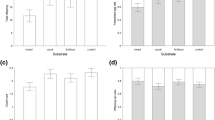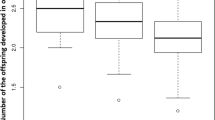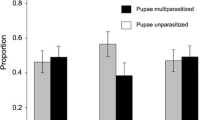Abstract
We report experiments using two closely related species of alysiine braconids directed at understanding how gregarious development evolved in one subfamily of parasitoid wasps. Theoretical models predict that once siblicide between parasitoid wasps has evolved, it can only be lost under stringent conditions, making the transition from solitary to gregarious development exiguous. Phylogenetic studies indicate, however, that gregariousness has independently arisen on numerous occasions. New theoretical models have demonstrated that if gregarious development involves reductions in larval mobility, rather than a lack of fighting ability (as in the older models), the evolution of gregariousness is much more likely. We tested the predictions of the older tolerance models (gregariousness based on non-fighting larval phenotypes) and the reduced mobility models (gregariousness based on non-searching larval phenotypes) by observing larval movement and the outcome of interspecific competition between Aphaereta genevensis (solitary) and A. pallipes (gregarious) under multiparasitism. Differences in larval mobility matched the prediction of the reduced mobility model of gregarious development, with the solitary A. genevensis having larvae that are much more mobile. The proportion of hosts producing the solitary species significantly declined after subsequent exposure to females of the gregarious species. This contradicts the prediction of the older models (fighting vs non-fighting phenotypes), under which any competitive interactions between solitary and gregarious larvae will result in a highly asymmetrical outcome, as the solitary species should be competitively superior. The observed outcome of interspecific competition offers evidence, with respect to this subfamily, in favour of the new models (searching vs non-searching phenotypes).


Similar content being viewed by others
References
van Achterberg C (1998) Phaenocarpa helophilae spec. nov. (Hymenoptera: Braconidae), a gregarious parasitoid of Helophilus larvae (Diptera: Syrphidae), with notes on related species. Zool Meded 72:15–27
van Baaren J, Boivin G, le Lannic J, Nénon J-P (1997) The male and female first instar larvae of Anaphes victus and A. listronoti (Hymenoptera, Mymaridae). Zoomorphology 117:189–197
Belshaw R, Fitton M, Herniou E, Gimeno C, Quicke DLJ (1998) A phylogenetic reconstruction of the Ichneumonoidea (Hymenoptera) based on the D2 variable region of 28S ribosomal RNA. Syst Entomol 23:109–123
Boivin G (1986) Anaphes sordidatus (Girault) (Hymenoptera: Mymaridae), an egg parasite of the carrot weevil, Listronotus oregonesis (Le Conte). Can Entomol 118:393–394
Boivin G, van Baaren J (2000) The role of larval aggression and mobility in the transition between solitary and gregarious development in parasitoid wasps. Ecol Lett 3:469–474
Brodeur J, Boivin G (2004) Functional ecology of immature parasitoids. Annu Rev Entomol 49:27–49
Carton Y, Bouletreau M, van Alphen JJM, van Lenteren JC (1986) The Drosophila parasitic wasps. In: Ashburner M, Carson H, Thompson JN (eds) The genetics and biology of Drosophila, vol 3E. Academic, London, pp 347–394
Cheplick GP (1992) Sibling competition in plants. J Ecol 80:567–575
Crawley MJ (1993) GLIM for ecologists. Blackwell, Oxford
Cruz YP (1981) A sterile defender morph in a polyembryonic hymenopterous parasite. Nature 294:446–447
Cruz YP (1986) The defender role of the precocious larvae of Copidosomopsis tanytmemus Caltagirone (Encyrtidae, Hymenoptera). J Exp Zool 237:309–318
Darwin CR (1859) On the origin of species by means of natural selection. John Murray, London
Elgar MA, Crespi BJ (1992) Cannibalism: ecology and evolution among diverse taxa. Oxford University Press, Oxford
Fleming JGW (1992) Polydnaviruses: mutualists and pathogens. Annu Rev Entomol 37:401–425
Gimeno C, Belshaw R, Quicke DLJ (1997) Phylogenetic relationships of the Alysiinae/Opiinae (Hymenoptera: Braconidae) and the utility of cytochrome b 16 s and 28 s D2 rRNA. Insect Mol Biol 6:273–284
Godfray HCJ (1987) The evolution of clutch size in parasitic wasps. Am Nat 129:221–233
Godfray HCJ (1994) Parasitoids: behavior and evolutionary ecology. Princeton University Press, Princeton
Godfray HCJ (1995) Evolutionary theory of parent-offspring conflict. Nature 376:133–138
Grbíc M, Ode PJ, Strand MR (1992) Sibling rivalry and brood sex ratios in polyembryonic wasps. Nature 360:254–256
Griffin AS, West SA (2002) Kin selection: fact and fiction. Trends Ecol Evol 17:15–21
Hamilton WD (1963) The evolution of altruistic behavior. Am Nat 97:354–356
Hamilton WD (1964a) The genetical evolution of social behaviour I. J Theor Biol 7:1–16
Hamilton WD (1964b) The genetical evolution of social behaviour II. J Theor Biol 7:17–52
Hamilton WD (1972) Altruism and related phenomena, mainly in social insects. Annu Rev Ecol Syst 3:193–232
Hamilton WD, May RM (1977) Dispersal in stable habitats. Nature 269:578–581
Harvey JA, Kadash K, Strand MR (2000a) Differences in larval feeding behaviour correlate with altered developmental strategies in two parasitic wasps: implications for the size-fitness hypothesis. Oikos 88:621–629.
Harvey JA, Corley LS, Strand MR (2000b) Competition induces adaptive shifts in caste ratio of a polyembryonic wasp. Nature 406:183–186
Harvey PH, Pagel MD (1991) The comparative method in evolutionary biology. Oxford University Press, Oxford
Harvey PH, Partridge L (1987) Murderous mandibles and black holes in hymenopteran wasps. Nature 326:128–129
Kfir R, van Hamburg H (1988) Interspecific competition between Telenomus ullyetti (Hymenoptera: Scelionidae) and Trichogrammatoidea lutea (Hymenoptera: Trichogrammatidae) parasitizing eggs of the cotton bollworm Heliothis armiger in the laboratory. Environ Entomol 17:664–670
Khoo BK, Forgash AJ, Respicio NC, Ramaswamy SB (1985) Multiple progeny production by gypsy moth parasites Brachymeria spp (Hymenoptera: Chalcididae), following exposure to diflubenzuron. Environ Entomol 14:820–825
Laing JE, Corrigan JE (1987) Intrinsic competition between the gregarious parasite Cotesia glomeratus and the solitary parasite Cotesia rubecula (Hymenoptera: Braconidae) for their host Artogeia rapae (Lepidoptera: Pieridae). Entomophaga 32:493–501
Lawton JH, Hassell MP (1981) Asymmetrical competition in insects. Nature 289:793–795
le Masurier AD (1987) A comparative study of the relationship between host size and brood size in Apanteles spp. (Hymenoptera: Braconidae). Ecol Entomol 12:383–393
Mackauer M (1990) Host discrimination and larval competition in solitary endoparasitoids. In: Mackauer M, Ehler LE, Roland J (eds) Critical issues in biological control. Intercept, Andover, pp 41–62
Mackauer M, Bai B, Chow A, Danyk T (1992) Asymmetric larval competition between two species of solitary parasitoid wasps: the influence of superparasitism. Ecol Entomol 17:233–236
Marktl RC, Stauffer C, Schopf A (2002) Interspecific competition between the braconid endoparasitoids Glyptapanteles porthetriae and Glyptapanteles liparidis in Lymantria dispar larvae. Entomol Exp Appl 105:97–109
Marris GC, Casperd J (1996) The relationship between conspecific superparasitism and the outcome of in vitro contests staged between different larval instars of the solitary endoparasitoid Venturia canescens. Behav Ecol Sociobiol 39:61–69
Matthews RW (1975) Courtship in parasitic wasps. In: Price PW (ed) Evolutionary strategies of parasitic insects and mites. Plenum, New York, pp 66–82
Mayhew PJ (1998a) The evolution of gregariousness in parasitoid wasps. Proc R Soc London B 265:383–389
Mayhew PJ (1998b) The life-histories of parasitoid wasps developing in small gregarious broods. Neth J Zool 48:225–240
Mayhew PJ, Hardy ICW (1998) Nonsibilicidal behavior and the evolution of clutch size in bethylid wasps. Am Nat 151:409–424
Mayhew PJ, van Alphen JJM (1999) Gregarious development in alysiine parasitoids evolved through a reduction in larval aggression. Anim Behav 58:131–141
Miller JC (1982) Life-history of insect parasitoids involved in successful multiparasitism. Oecologia 54:8–9
Mock DW, Parker GA (1997) The evolution of sibling rivalry. Oxford University Press, Oxford
Nénon J-P, Boivin G, le Lannic J, van Baaren J (1995) Functional morphology of the mymariform and sacciform larvae of the egg parasitoid Anaphes victus Huber (Hymenoptera: Mymaridae). Can J Zool 73:996–1000
Nicholson AJ (1954) An outline of the dynamics of animal populations. Aust J Zool 2:9–65
Nixon GEL (1965) A reclassification of the tribe Microgasterini (Hymenoptera: Braconidae). Bull Br Museum Nat Hist Entomol Suppl 2:1–284
Ode PJ, Rosenheim JA (1998) Sex allocation and the evolutionary transition between solitary and gregarious parasitoid development. Am Nat 152:757–761
Pexton JJ, Mayhew PJ (2001) Immobility: the key to family harmony? Trends Ecol Evol 16:7–9
Pexton JJ, Rankin DJ, Dytham C, Mayhew PJ (2003) Asymmetric larval mobility and the evolutionary transition from siblicide to nonsiblicidal behavior in parasitoid wasps. Behav Ecol 14:182–193
Quicke DLJ (1993) The polyphyletic origin of endoparasitism in the cyclostome lineages of Braconidae (Hymenoptera): a reassessment. Zool Meded 67:159–177
Quicke DLJ (1997) Parasitic wasps. Chapman and Hall, New York
Quicke DLJ, van Achterberg C (1990) Phylogeny of the subfamilies of the Braconidae (Hymenoptera: Ichneumonoidea). Zool Verh 285:1–95
Rosenheim JA (1993) Single sex broods and the evolution of nonsiblicidal parasitoid wasps. Am Nat 141:90–104
Salt G (1961) Competition among insect parasitoids. Symp Soc Exp Biol 15:96–119
Schluter D (2000) The ecology of adaptive radiation. Oxford University Press, Oxford
Shaw MR, Huddleston T (1991) Classification and biology of Braconid Wasps (Hymenoptera: Braconidae): handbooks for the identification of British insects. Natural History Museum, London
Skinner SW (1985) Clutch size as an optimal foraging problem for insects. Behav Ecol Sociobiol 17:231–238
Stephens DW, Krebs JR (1986) Foraging theory. Princeton University Press, Princeton
Strand MR (1986) The physiological interactions of parasitoids with their hosts and their influence on reproduction strategies. In: Waage J, Greathead D (eds) Insect parasitoids. Academic, London, pp 97–136
Strand MR, Vinson SB (1984) Facultative hyperparasitism by the egg parasitoid Trichogramma pretiosum (Hymenoptera, Trichogrammatidae). Ann Entomol Soc Am 77:679–686
Strand MR, Johnson JA, Culin JD (1990) Intrinsic interspecific competition between the polyembryonic parasitoid Copidosoma floridanum and solitary endoparasitoid Microplitis demolitor in Pseudoplusia includens. Entomol Exp Appl 55:275–284
van Strien-van Liempt WTFH (1983) The competition between Asobara tabida Nees and Leptopilina heterotoma (Thomson) in multiparasitized hosts. I. The course of competition. Neth J Zool 33:125–163
Trivers RL (1974) Parent-offspring conflict. Am Zool 14:249–264
Utsunomiya A, Iwabuchi K (2002) Interspecific competition between the polyembryonic wasp Copidosoma floridanum and the gregarious endoparasitoid Glyptapanteles pallipes. Entomol Exp Appl 104:353–362
Vinson SB, Hegazi EM (1998) A possible mechanism for the physiological suppression of conspecific eggs and larvae following superparasitism by solitary endoparasitoids. J Insect Physiol 44:703–712
Waage JK, Godfray HCL (1985) Reproductive strategies and population ecology of insect parasitoids. In: Sibly RM, Smith RH (eds) Behavioural ecology: ecological consequences of adaptive behaviour. Blackwell, Oxford, pp 449–470
West SA, Murray MG, Machado CA, Griffin AS, Herre EA (2001) Testing Hamilton’s rule with competition between relatives. Nature 409:510–513
West SA, Pen I, Griffin AS (2002) Co-operation and competition between relatives. Science 296:72–75
Wharton RA (1977) New World Aphaereta species (Hymenoptera: Braconidae: Alysiinae), with a discussion of terminology used in the tribe Alysiini. Ann Entomol Soc Am 70:782–803
Wharton RA (1980) Review of the nearctic Alysiini species (Hymenoptera, Braconidae) with discussion of generic relationships within the tribe. Univ California Publ Entomol 88:1–112
Wharton RA (1984) Biology of the Alysiini (Hymenoptera, Braconidae), parasitoids of cyclorrhaphous Diptera. Tech Monogr Tex Agric Exp Stat 11:1–39
Whitfield JB (1997) Subfamily Microgastrinae. In: Wharton RA, Marsh PM, Sharkey MJ (eds) Manual of the new world genera of the family Braconidae (Hymenoptera). The International Society of Hymenopterists, Washington, pp 332–364
Williams GC (1992) Natural selection: domains, levels and challenges. Oxford University Press, Oxford
Williams GC, Williams DC (1957) Natural selection of individually harmful social adaptations among sibs with special reference to social insects. Evolution 11:32–39
Wilson DS, Dugatkin LA (1997) Group selection and assortative interactions. Am Nat 149:336–351
Wilson DS, Pollock GB, Dugatkin LA (1992) Can altruism evolve in purely viscous populations? Evol Ecol 6:331–341
Acknowledgements
J.J.P. was funded by a NERC studentship. The authors also warmly thank Jeremy Searle, Stu West, and an anonymous referee for constructive comments on a previous version of the manuscript.
Author information
Authors and Affiliations
Corresponding author
Rights and permissions
About this article
Cite this article
Pexton, J.J., Mayhew, P.J. Competitive interactions between parasitoid larvae and the evolution of gregarious development. Oecologia 141, 179–190 (2004). https://doi.org/10.1007/s00442-004-1659-3
Received:
Accepted:
Published:
Issue Date:
DOI: https://doi.org/10.1007/s00442-004-1659-3




